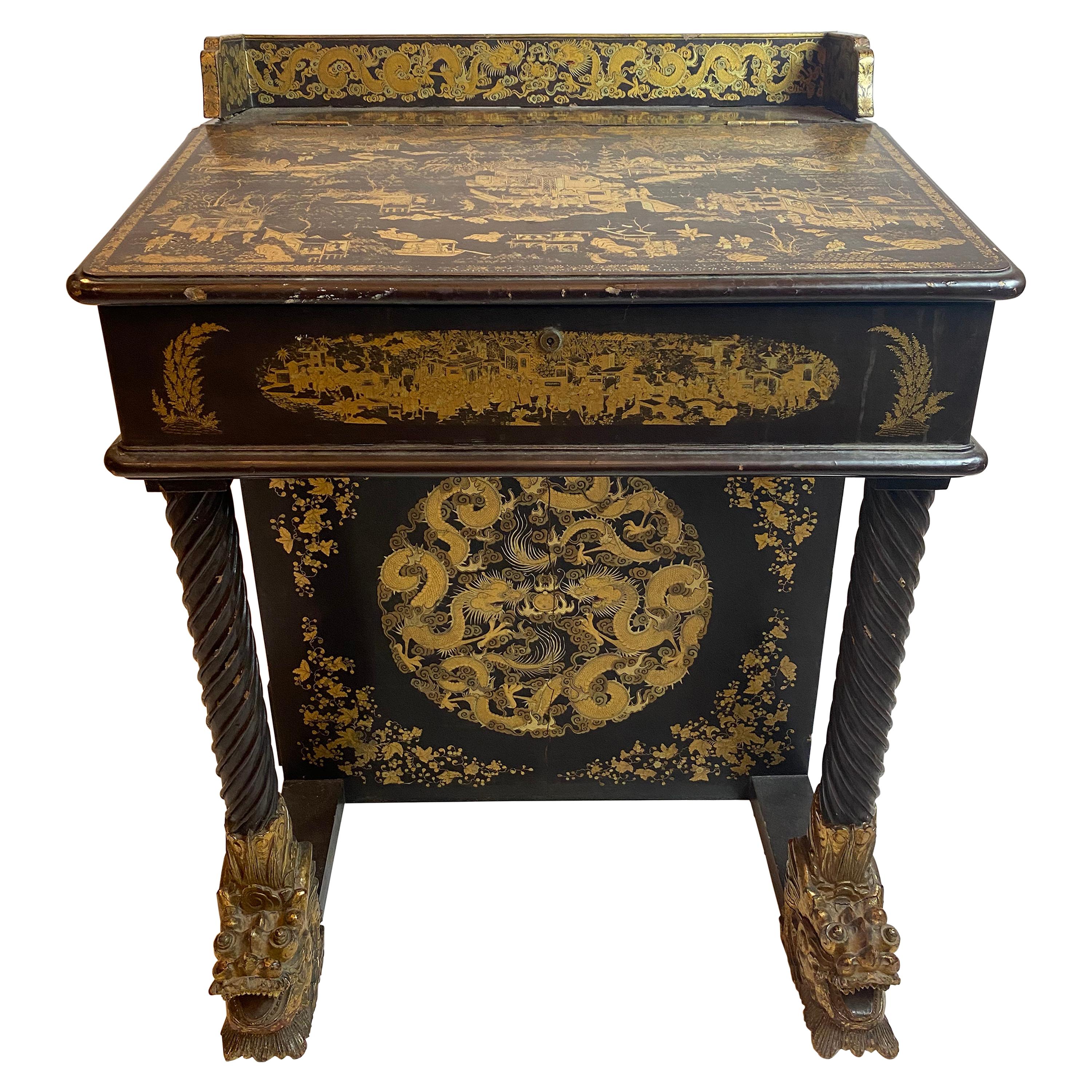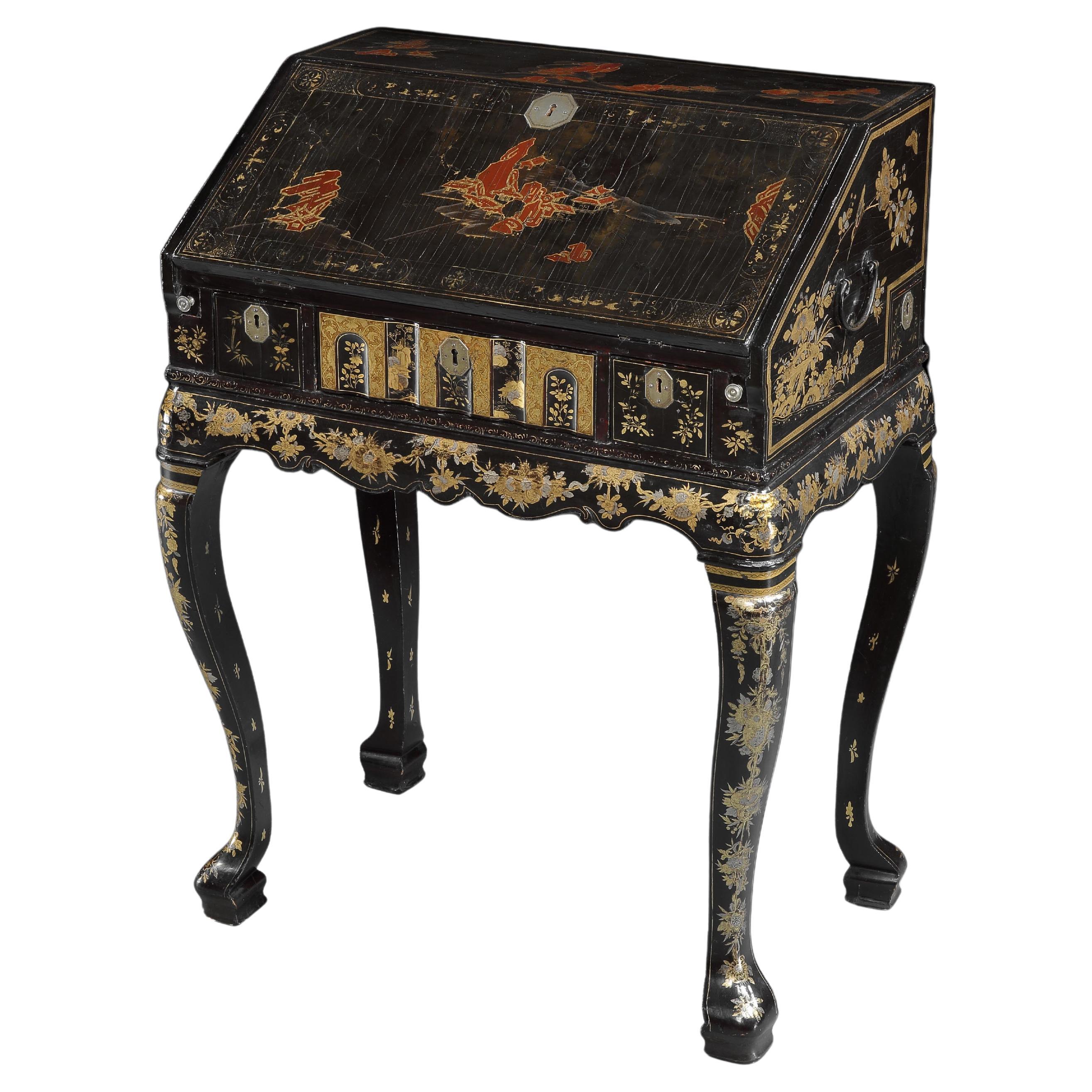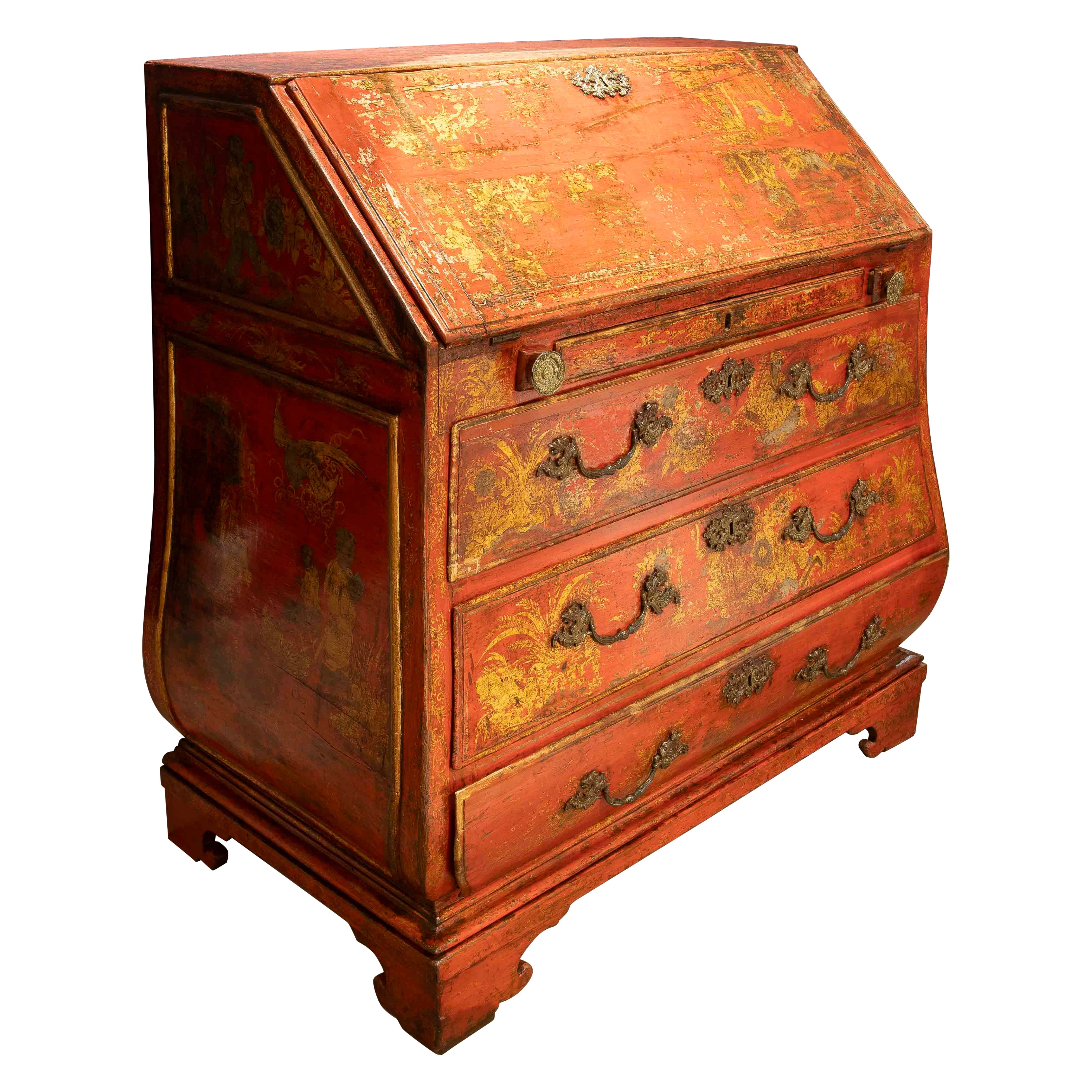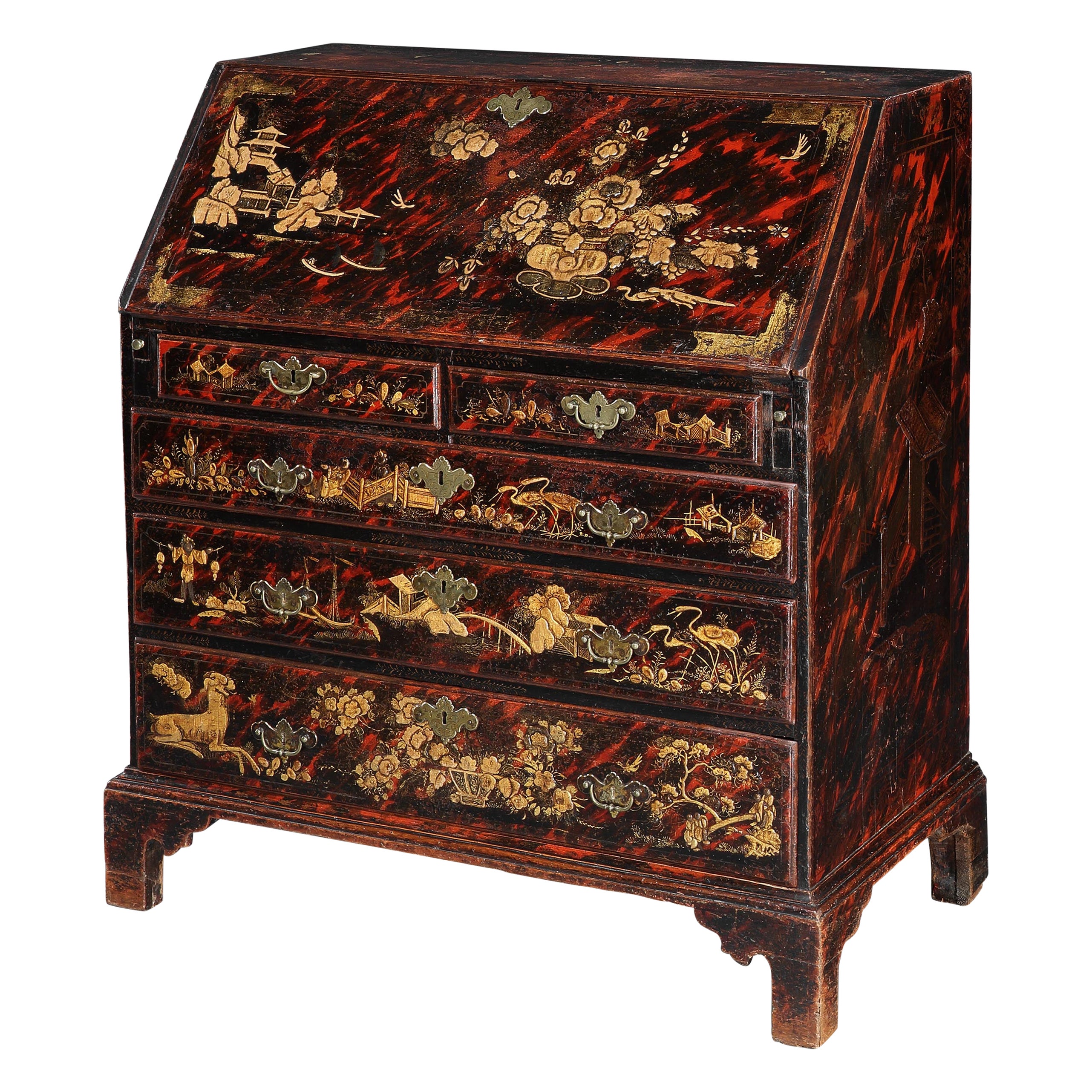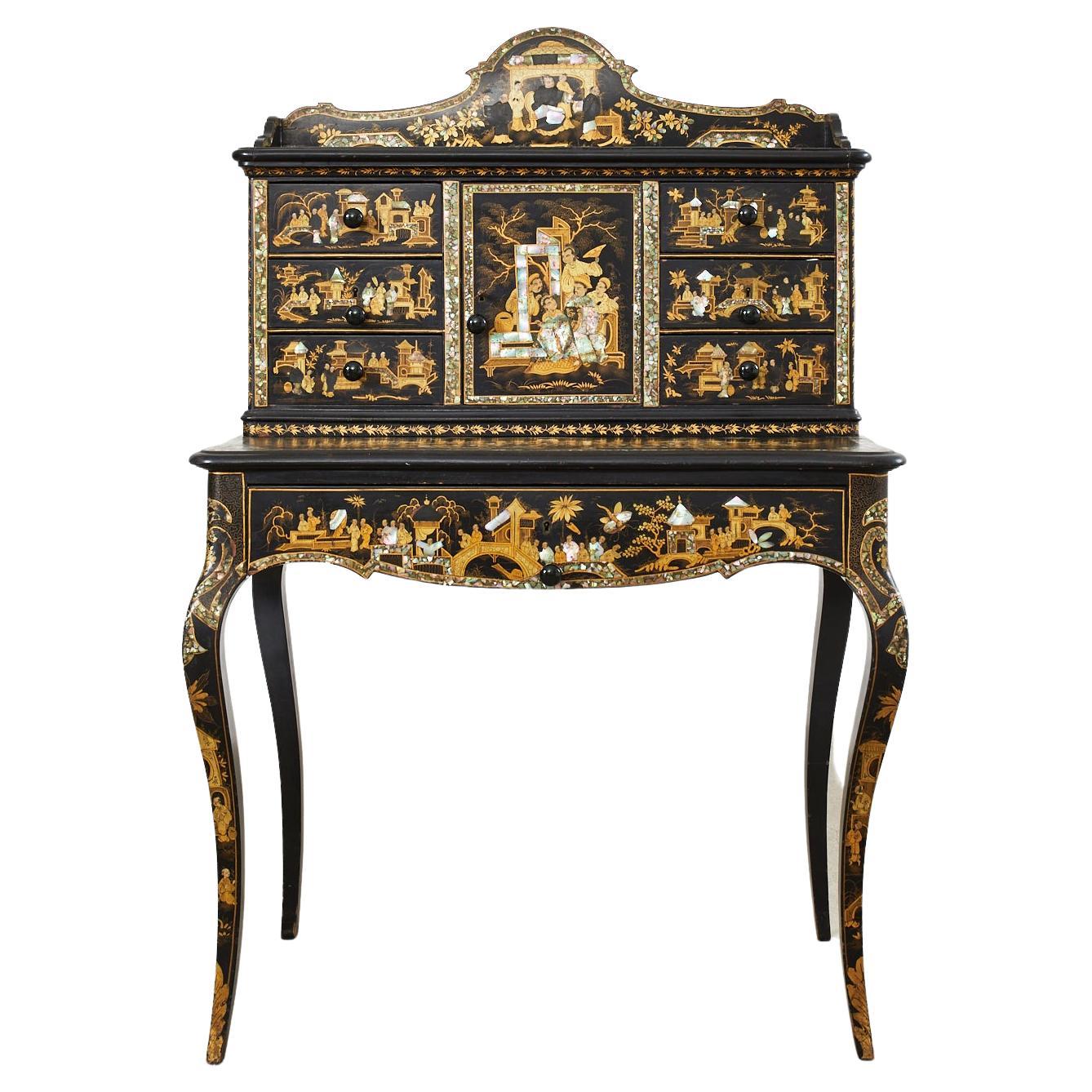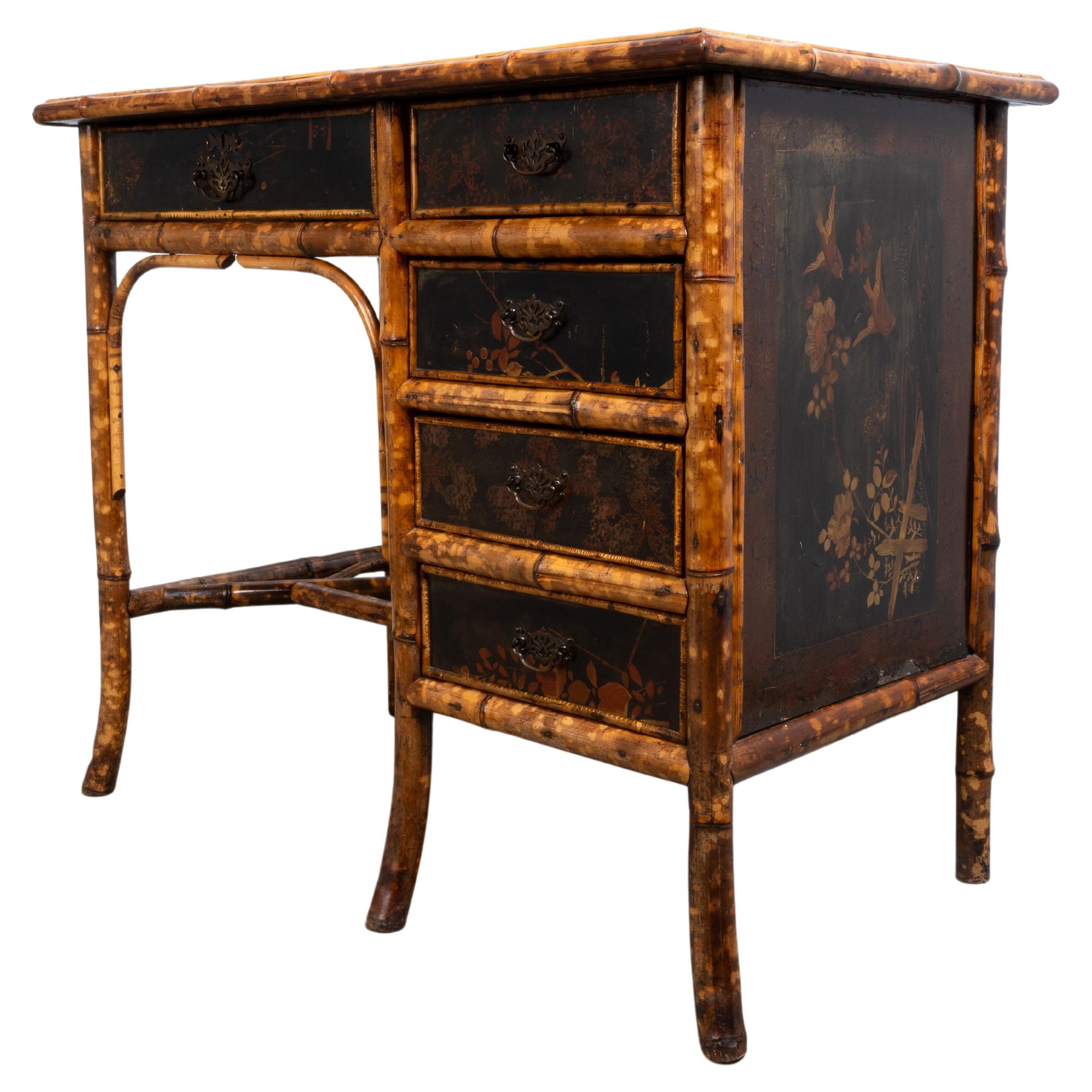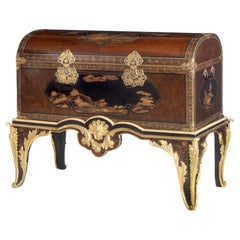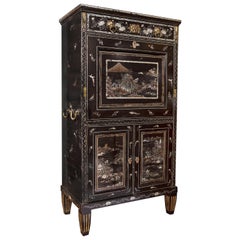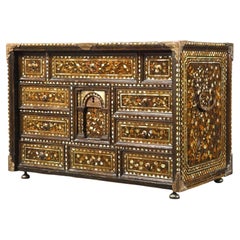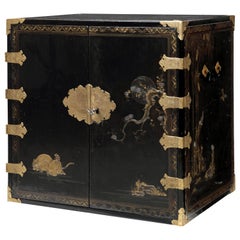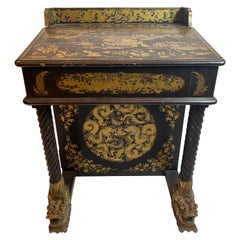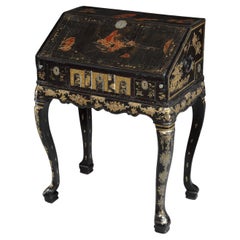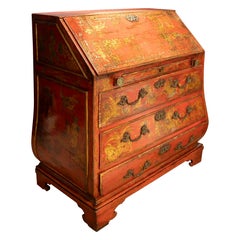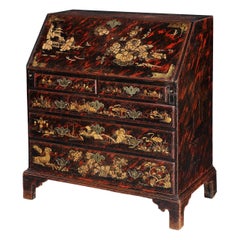Items Similar to 18th Century Chinese Export Lacquer Chinoiserie Bureau Desk for the Dutch Market
Want more images or videos?
Request additional images or videos from the seller
1 of 7
18th Century Chinese Export Lacquer Chinoiserie Bureau Desk for the Dutch Market
$89,938.42
£66,905.10
€75,000
CA$123,156.45
A$136,933.22
CHF 71,498.97
MX$1,666,810.72
NOK 912,295.75
SEK 854,777.52
DKK 570,933.58
Shipping
Retrieving quote...The 1stDibs Promise:
Authenticity Guarantee,
Money-Back Guarantee,
24-Hour Cancellation
About the Item
An extremely rare, possibly unique, Chinese export lacquer bureau for the Dutch market
Canton, circa 1737
H. 118 x W. 102.5 x D. 63 cm
Provenance:
- Private collection, The Netherlands
- J.K. Driessen Antiques, Arnhem (Art Fair Breda, 1989)
- Noble collection, Belgium
Literature:
- C.J.A. Jörg, ’De handel van de V.O.C. in Oosters lakwerk in de 18de eeuw’ in: Nederlands Kunsthistorisch Jaarboek , Jr. 31 (1980), pp. 355-363 (ill.)
- Annigje Hofstede, Nederlandse meubelen van Barok tot Biedermeier, 1700-1830, Waanders, Zwolle 2004, pp. 35-37 (ill.)
This lacquer bureau is one of the four writing desks purchased in Canton in 1737, and as far as is known, this is the only remaining bureau of its type from the period. As the VOC believed that large pieces of import took up too much valuable space in their trading ships, few Chinese furniture pieces were crafted for the Dutch market. Even fewer have survived the test of time.
After 1693, Japanese lacquerware can no longer be found in the VOC books, probably because it had become too costly for import. European fashion and the production of unique imitation lacquer must have also contributed to the halt of its import. The demand, however, remained high. In 1730, the Lords XVII, the directors of the VOC, sent several models of Japanese lacquerware to Batavia with the question if it could be produced for a lower price in China. After 1729, a direct sailing route was used from the Netherlands to Canton, and the trade no longer went through Batavia.
?The Middelburg chamber of the VOC auctioned off a large quantity of tea trays made of Chinese lacquer in 1734, which was a great success resulting in more orders. In 1737, two shipments of lacquer trays were ordered: one for Amsterdam and one for Middelburg. Each city received three boxes with the same content. The first shipment box also contained a ‘cabinet’ or ‘writing office’, and in it had been packed a table-top (without a foot element) in the lower drawer, 5 trays in the second drawer, 15 elongated trays; in the third drawer 45 elongated tea trays, 5 sets of 5 pieces of powder boxes and so on. Space was costly, so each drawer was packed with smaller lacquer pieces. The second box had the same contents, and the third one was filled with 500 serving trays and 500 teacups. In 1738, this assortment of lacquer was sold at auction. The pieces of furniture were an exception to the orders, and the purchase lists reveal that cabinets were no longer ordered in the following years.
This writing desk was made after a Dutch example, and it was crafted especially for the Dutch market rather than to the taste of English buyers, as is made clear by its slightly organ-curved front. From 1730, these fall-front bureaus were quite popular in The Netherlands, often featuring diagonally positioned side stiles. This export lacquer bureau is exceptionally well-preserved with its original brass handles and lock escutcheon.
Decorated throughout with gilt landscapes and floral details on a black lacquer background. The drawers, fall front and side panels are richly adorned with images of Chinese pavilions surrounded by pine trees and weeping willows. The desk's interior comprises twelve drawers with floral decor and two standing fluted drawers trimmed with capitals and basements. The centre features a cupboard door with a decoration of a vase filled with flowers, a symbol of peace and tranquillity in China. The interiors of the drawers are finished with gold powder lacquer. All drawers are inscribed with a Chinese character. The desk also contains a storage compartment, which opens with a sliding panel (in French à coulisse, and a keldertje in Dutch). Beneath the fall front are four drawers flanked by fluted and gilded stiles. The Chinese cabinet maker has followed his own interpretation of the claw-and-ball feet motifs, which feature taotie masks above them. This motif of an animal mask dates back thousands of years and can be found on Chinese bronzes from the dawn of civilisation. The bureau’s manner of construction is quite interesting and is carried out in Cypresswood, which differs from the wood used by European craftsmen. The joints of the drawers are not forked as they usually are in Europe but are somewhat rectangular in shape.
- Dimensions:Height: 46.46 in (118 cm)Width: 40.36 in (102.5 cm)Depth: 24.81 in (63 cm)
- Style:Chinese Export (Of the Period)
- Materials and Techniques:
- Place of Origin:
- Period:
- Date of Manufacture:circa 1737
- Condition:Wear consistent with age and use.
- Seller Location:Amsterdam, NL
- Reference Number:1stDibs: LU5458234423832
About the Seller
5.0
Recognized Seller
These prestigious sellers are industry leaders and represent the highest echelon for item quality and design.
Established in 1985
1stDibs seller since 2020
23 sales on 1stDibs
Typical response time: 2 hours
- ShippingRetrieving quote...Shipping from: Amsterdam, Netherlands
- Return Policy
Authenticity Guarantee
In the unlikely event there’s an issue with an item’s authenticity, contact us within 1 year for a full refund. DetailsMoney-Back Guarantee
If your item is not as described, is damaged in transit, or does not arrive, contact us within 7 days for a full refund. Details24-Hour Cancellation
You have a 24-hour grace period in which to reconsider your purchase, with no questions asked.Vetted Professional Sellers
Our world-class sellers must adhere to strict standards for service and quality, maintaining the integrity of our listings.Price-Match Guarantee
If you find that a seller listed the same item for a lower price elsewhere, we’ll match it.Trusted Global Delivery
Our best-in-class carrier network provides specialized shipping options worldwide, including custom delivery.More From This Seller
View All17th-Century Japanese Namban Lacquer Coffer on French Stand, Possibly by Boulle
By André-Charles Boulle
Located in Amsterdam, NL
An impressive and large Japanese 'Namban' transition-style lacquer coffer with fine gilt copper mounts on a French Re´gence base, possibly by André-Charles Boulle (1642-1732)
Kyoto, 1640-1650, the base 18th century
?The coffer with shaped cartouches on a nashiji ground on the lid, front and sides, with fine decorations in various techniques: takimaki-e (high relief), tsuke-gaki (drawing with narrow lacquer lines and over sprinkling with gold and silver), usuniku-takamei-e (demi relief), kimekomi (pushed inside) and accents of kirigane (small geometrical metal mosaics). Inside the cartouche on the lid a landscape with volcanos...
Category
Antique 17th Century Japanese Lacquer
Materials
Brass, Ormolu
Japanese Export Lacquer Mother-of-Pearl Secretaire for the American Market
Located in Amsterdam, NL
A rare Japanese export lacquered secretaire for the American market
Circa 1800-1830, Colonial
Overall densely decorated with flower sprays and landscapes, minutely inlaid with ...
Category
Antique 1810s Japanese Edo Furniture
Materials
Mother-of-Pearl, Wood
Portuguese-colonial Japanese Namban lacquer Vargueno Cabinet, circa 1600
Located in Amsterdam, NL
A Portuguese-colonial Japanese Namban lacquer vargueno cabinet
Momoyama period, circa 1600
H. 43 x W. 64.5 x D. 36 cm
Wood, black lacquered and deco...
Category
Antique Early 1600s Japanese Antiquities
Materials
Gold, Brass
Rare Charming 17th Century Japanese Lacquer Cabinet with Gilt-Bronze Mounts
Located in Amsterdam, NL
A fine Japanese pictoral style lacquer cabinet with gilt-metal mounts
Kyoto, Edo period, 1670-1690
Decorated in Japanese relief lacquer work, black lacquer ground decorated...
Category
Antique Late 17th Century Japanese Furniture
Materials
Bronze
$44,930 Sale Price
25% Off
Free Shipping
Large Royal Early 17th Century Japanese Lacquer Chest with Gilt-Bronze Mounts
Located in Amsterdam, NL
A large Japanese transitional lacquer chest with gilt-metal mounts
Edo period, early 17th century
The rectangular chest with flat hinged lid decorated in gold, silver, and red ...
Category
Antique Early 17th Century Japanese Blanket Chests
Materials
Bronze
17th Century Japanese Export Lacquer Cabinet with Depiction the Dutch Tradepost
Located in Amsterdam, NL
A highly important Japanese export lacquer cabinet with depiction of the Dutch East India Company tradepost Deshima and the annual Dutch delegation on its way to the Shogun in Edo
Edo period, circa 1660-1680
H. 88 x W. 100.5 x D. 54 cm
This cabinet includes a later European japanned stand, but also a modern powder-coated steel frame.
The latter can be designed and added to your specific needs.
The sides and front of the rectangular two-door cabinet are embellished in gold and silver hiramaki-e and takamaki-e on a black roiro lacquer ground with a continuous design. The two doors depict a long procession of numerous figures travelling on foot and horseback along buildings and a pagoda into a mountainous landscape. This is the annual court journey, Hofreis, of the Dutch from Nagasaki to the Shogun’s court in Edo. Three horseback riders are dressed as Dutch merchants and a fourth figure, probably het Opperhoofd, is seen inside a palanquin, norimon. Just about to cross the bridge, two men are carrying a cabinet like the present one.
Many Japanese figures on either side of the procession are engaged in various activities; some play musical instruments on board of small boats, others are fishing; figures inside buildings are depicted playing go, and farmers are tending to their rice paddocks. The upper part of the right door shows a large mansion, probably the local daimyo’s castle, with men kneeling before a man in the central courtyard.
The court journey fits in with the foreign policy of the shogunate which accorded a role to the VOC alongside China, Korea, and the Ryukyu Islands who also had to pay tribute. However, the VOC employees were traders, having low status in Japan’s social hierarchy, and they were received with less deference than were the state embassies from Korea and the Ryukyu Islands. Nevertheless, the contacts with the Dutch were a welcome source of information to the Shogun about Europe and European science and technology.
The left side of the cabinet depicts, in mirror image, a rare view of the artificial fan-shaped Deshima Island, the trading post for the Dutch in Japan. The island, where the Dutch flag flies, is surrounded by small Japanese boats and an anchored three-masted fluyt (cargo ship), flying Dutch flags, with on the stern the VOC monogram. On the bottom right a busy street of Nagasaki is shown, bordered by shops and leading up to the stone bridge. On the island the trees are beautifully painted, two cows can be seen, and the flagpole, all in very fine detail. Dutchmen and enslaved Malay are visible outside the buildings and two Japanese figures, probably guards, sit in a small hut in the centre.
A maximum of fifteen to twenty Dutchmen lived on the island at any time and soldiers or women were not allowed. Restrictions on Deshima were tight, and the merchants were only allowed to leave the island by special permission. The Opperhoofd had to be replaced every year, and each new Opperhoofd had to make a court journey to pay tribute, present gifts, and to obtain permission to Margaret Barclay eep on trading. In the distance, many birds fly above the hills and a four-story pagoda can be seen. The right side of the cabinet is painted with other horse riders and their retinue journeying through mountains.
The pair of doors to the front open to reveal ten rectangular drawers. The drawers are decorated with scenes of birds in flight and landscapes with trees and plants. The reverse of the left door with two thatched buildings, one with a ladder, underneath a camelia tree with large blooms; the right door with a three-story pagoda nestled among trees and both doors with a flying phoenix, ho-oo bird. The cabinet, with elaborately engraved gilt copper mounts, hinges, lock plates and brass handles, is raised on an 18th-century English japanned wood stand.
A pair of large cabinets...
Category
Antique 17th Century Japanese Edo Lacquer
Materials
Copper, Gold
$1,497,679
Free Shipping
You May Also Like
19th Century Chinese Export Lacquer and Gilt Davenport Desk
Located in Brea, CA
Early 19th century Chinese export lacquer and gilt Davenport desk, the entire finely decorated with the typical figural landscape and foliate gilt decoration, the sloped top opening ...
Category
Antique Early 19th Century Chinese Qing Lacquer
Materials
Lacquer
Chinese Export 18th Century Lacquer Bureau on Stand
Located in London, GB
A fine and rare mid 18th century Chinese Export lacquer bureau on stand. Probably made in Canton specifically for the export trade to meet the demands of the European market. Beautifully decorated throughout with gilded decorations on a black lacquer background. The writing section is fitted with double serpentine fronted drawers and pigeon holes - all profusely decorated with sprigs of flowers, foliage and butterflies. The apron frieze contains three working drawers, the central drawer arcaded. With a small pull out pen drawers...
Category
Antique Mid-18th Century Chinese Chinese Export Desks and Writing Tables
Materials
Lacquer
1850s Chinese Lacquered Style Secretaire with Decoration of Traditional Scenes
Located in Marbella, ES
Impressive antique secretary of Chinese style, with a vibrant red lacquer finish and richly ornamental gold details. Its structure with curved and robust lines gives it a unique char...
Category
Antique 18th Century Spanish Desks and Writing Tables
Materials
Wood
Bureau Desk Fall Front Japanning Tortoishell Gilding Chinoiserie
Located in BUNGAY, SUFFOLK
A rare, late-17th century / early-18th century, fall front bureau with gilded Chinoiserie Japanning & faux tortoishell ground.
“Before Japan was made in England, the imitation of tortoise-shell was much in request for cabinets, tables and the like“. John Stalker and George Parker, a treatise on Japanning and varnishing (originally published in 1668), Alec Tiranti, 1998, p. 75.
- This bureau is decorated in one of the most fashionable styles of the Baroque period, Chinese lacquer with gilded decoration and tortoiseshell imitation ground and would have been a statement piece within the interior.
- The colours, which have become muted from atmospheric conditions over time, are still striking and colourful evoking warm and richness.
- It has come from a private collection where it has reputedly been for many generations which explains why it is in such original condition retaining the original hinges, lock and catches.
- Pieces of imitation tortoishell with gilded lacquer decoration are rare, the last piece I handled was a chest of drawers about 20 years ago.
- Tortoishell furniture was only affordable by royalty and the elite and the height of fashion in the 17th century, as was producing things that were not what they seemed. One of the oldest examples of faux material from the Baroque period is at Rosenborg Castle in Copenhagen where, in 1667, the royal bed...
Category
Antique 17th Century Italian Chinoiserie Desks
Materials
Lacquer
19th Century English Chinoiserie Ladies Secretaire Writing Table
Located in Rio Vista, CA
Extraordinary 19th century English ladies secretaire desk or writing table. The two part desk was made in the Chinoiserie revival period of Europe ...
Category
Antique 19th Century English Chinoiserie Secretaires
Materials
Brass
Antique 19th Century Anglo-Chinese Bamboo Lacquered Desk
Located in London, GB
Antique 19th Century Anglo-Chinese Bamboo Lacquered Desk
Aesthetic Movement, England, C.1880
Leather inset surface
Presented in excellent condition commensurate of age.
Category
Antique 19th Century English Aesthetic Movement Desks
Materials
Leather, Bamboo, Lacquer
More Ways To Browse
Mid Century Black Lacquer
French Lacquer
Brown Lacquered Cabinet
Black Lacquer French
Black Gold Lacquer
Black Lacquer Storage
Black Lacquer Storage Cabinet
Lacquered Wood Panel
French Lacquer Cabinet
Black Lacquer Decor
Dutch China
French Market Collection Furniture
French Market Collection
Lacquered Chinese Table
Bureau Desk
Black Lacquer Gold Tables
Large Lacquer Cabinet
Black Lacquer Brass Cabinet
